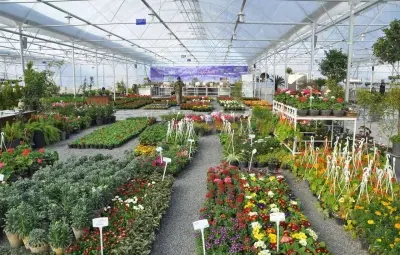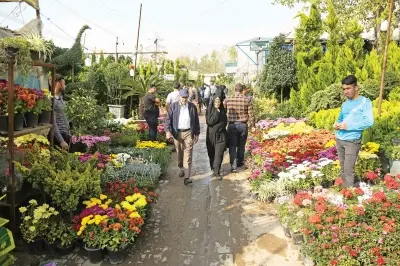Supply and demand market of ornamental flowers and plants

The market for ornamental flowers and plants can vary in terms of its structure. It can range from local markets, where small-scale producers sell directly to consumers, to global markets involving large-scale production, wholesale distribution, and international trade. The market structure influences factors such as price formation, competition, and market access for producers and consumers. The price of ornamental flowers and plants is primarily influenced by the intersection of supply and demand. However, other factors may also come into play, such as production costs, transportation expenses, and market competition. Additionally, factors like flower quality, rarity, and uniqueness can lead to price differentiation within the market.
Consumer awareness and preferences play a crucial role in shaping the market for ornamental flowers and plants. Increasingly, consumers are seeking information about the origin, sustainability, and ethical practices associated with the flowers and plants they purchase. Trends such as "green gifting," where eco-friendly and sustainable options are preferred, have influenced the demand for certain types of flowers and plants. Special events and celebrations significantly impact the demand for ornamental flowers and plants. Occasions like weddings, funerals, holidays, and religious festivals create spikes in demand, leading to price fluctuations and increased competition among producers. Floral arrangements and decorations are integral parts of these events, driving the demand for specific flower varieties and designs.
Supply and demand market of ornamental flowers and plants, Read More ...
Export value of flowers and ornamental plants in international trade

In order to be part of the valuable export goods in international trade, flowers and ornamental plants must have some special characteristics. Ornamental flowers for export must have excellent quality and superior appearance. This includes selecting flowers and plants with attractive colors, shapes and designs, health and freshness, the right size for the target market, and the absence of significant damage and disease.
For the export of flowers and ornamental plants, it is very important to comply with international standards, such as quality and safety standards. Some of these standards include ISO 9001 (Quality Management) and ISO 22000 (Food Safety Management). For the successful export of flowers and ornamental plants, a strong and effective supply chain management is very important. This includes processing, packaging, transportation, and distribution to the final destination. Optimum performance at each stage of the supply chain can maintain the quality and freshness of flowers and plants and gain the trust of international markets. To succeed in the global market, studying and analyzing the target markets and paying attention to the needs and preferences of customers is also very essential.
Export value of flowers and ornamental plants in international trade, Read More ...
The most important flowers and ornamental plants in West Asian countries

Flowers and ornamental plants in the countries of West Asia and the Middle East play an important role in beautifying the environment, connecting with culture and religion, industry and economy, and preserving biodiversity. In the countries of West Asia and the Middle East, some flowers and ornamental plants are known as the most important examples. These flowers and plants are important for many reasons, including beauty, resistance to the climatic conditions of the region, and cultural and religious significance.
The production and export of flowers and ornamental plants in some countries of this region is considered as an important industry that generates income and creates employment. Some of these flowers are considered valuable export products due to their high quality and the demands of the global market. Some of these flowers and plants are known as cultural and religious symbols in these regions. They are used in religious ceremonies, festivals and cultural events and have spiritual and traditional value. Paying attention to the flowers and ornamental plants of the region also helps to maintain biodiversity. These plants have diverse genetic resources, and their conservation helps to maintain biodiversity and special plant species in this region.
The most important flowers and ornamental plants in West Asian countries, Read More ...
Flowers and ornamental plants in the culture of West Asian (Middle East) people

Flowers and plants are often imbued with deep symbolic meanings in West Asian culture. They are associated with beauty, purity, love, and spirituality. Considered the "queen" of flowers, roses symbolize love and passion. They are commonly used in weddings, celebrations, and gifts. The fragrant jasmine flower represents purity, grace, and femininity. It is highly valued and used in perfumes, decoration, and traditional ceremonies. Tulips are associated with abundance, prosperity, and rebirth. They hold cultural significance and are widely cultivated and displayed. Lilies symbolize purity, renewal, and fertility. They are commonly used in religious ceremonies and festivals.
West Asia has a rich tradition of ornamental gardens and landscaping. Historic gardens, such as the Persian gardens, are renowned for their beauty, symmetry, and intricate design. These gardens often feature a diverse range of flowers, plants, and water features, creating serene and harmonious spaces. Flowers and ornamental plants are valued for their aesthetic appeal, enhancing the beauty of homes, public spaces, and events. They are used in floral arrangements, centerpieces, and as decorations during cultural festivals, weddings, and other special occasions. West Asian culture has a long history of utilizing plants and flowers for their medicinal and herbal properties. Traditional practices have emphasized the healing properties of various plants, such as lavender, chamomile, and henna.
Flowers and ornamental plants in the culture of West Asian (Middle East) people, Read More ...




